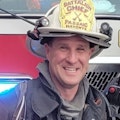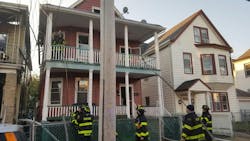After the Fire: Six-Post Fire Considerations
After a fire occurs, no matter how big or small, we must ensure that several tasks are performed for both the fire service and the citizens who we serve.
At times, the people who are affected by the fire might get overlooked. It’s our responsibility to ensure that the needs of the victims, aka customers, are met and that questions are answered to the best of our ability.
We also must guarantee that our people and equipment are ready to go back in service.
USFA’s ‘After the Fire’
In 2019, the U.S. Fire Administration (USFA) published “After the Fire.” It isn’t intended for fire departments but for the unfortunate individuals who suffer a fire loss. The 12-page document provides an action plan for the steps regarding their personal and financial loss. This document should be provided to anyone who was affected by a structure fire.
In addition, six items should be accomplished once a fire is out and you’re demobilizing your apparatus and personnel: tailboard talk, scene cleanup, answering neighbors’ questions, controlling utilities, investigation needs and notes, and documentation.
Tailboard talk
The tailboard talk is one of the most important meetings that’s convened post-fire with the first-arriving company and crew. It normally is performed by the incident commander (IC) or a senior officer.
One of the most important items is to ensure that there aren’t any hot spots. No one wants a rekindle.
Another important facet is to find out how the crews are physically and mentally after the incident. It’s important to know whether there are any injuries to the crew (as well as to see whether any equipment is missing or damaged).
The tailboard talk is also a perfect time to talk to the troops and thank them for their effort and professionalism in handling the incident. That said, for ICs, listening is more important than talking. Listen to the first-in officers and crews and let them brag for a moment about themselves and the job that they did.
Before sending the crews back to the firehouse, ensure that everyone rehabbed and did some sort of decontamination. The latter can be a quick rinse off of their turnout gear and/or utilization of wipes to help remove soot and carcinogens from their face, nose, head and neck. Also remind them to ensure that they wash up or shower as soon as possible once they are back at the station or home.
Check with the crews to see whether anything must be investigated immediately before the companies are released from the incident.
Of course, the tailboard talk is a precursor to an after-action review, which usually is done at a later date and goes more in depth.
Scene cleanup
Cleaning the scene helps with the rebuilding process for the property owner as well as the neighborhood.
Be sure that all companies have their tools and equipment with them. If any items are missing, obtain a location where they were last used or seen.
Be sure that the property owner contacted his/her insurance company for the next few steps in boarding up the building and their relocation for the night or longer. Try to obtain an exact location where the displaced occupants will be staying as well as a contact number for them.
In some municipalities, relocation officers can assist displaced individuals with temporary housing or shelter. The American Red Cross also helps displaced occupants.
It’s a good customer service practice to ensure that displaced occupants have a place to go immediately following the fire. If not, sometimes, they wind up back in the fire building after everyone has cleared. This is a danger to themselves as well as the fire service.
Answering neighbors’ questions & concerns
A fire in a neighborhood can be traumatic not only for the homeowner but for the neighbors as well. As we know, people have crazy imaginations. They might be fearful that their house might catch on fire even though the fire was extinguished at their neighbor’s house.
Answer their questions and ease their fears but always be truthful. This is a good time to educate on exit drills in the home and the use of smoke alarms and carbon monoxide alarms.
It also is a good idea to advise the neighbors to keep an eye on their neighbor’s house. Sometimes, unscrupulous people try to ransack or loot from the structure that had a fire. Advise the neighbors to notify the police department if anybody is on the property, particularly if they enter the building. The severity of the damage from the fire might require the building to be completely boarded up to prevent unwanted entry.
Taking the time to talk with the neighbors and answer their questions goes a long way to building trust and respect. We must remember that the fire service is a customer service industry.
Utilities controlled
Depending on the severity of the incident, some or all of the utilities might need to be shut down. Gas, electricity and water are the Big 3 that should be considered.
Securing the utilities as close to the issue/incident as possible is the most feasible. For example, if only one apartment in a complex was affected, only that apartment’s utilities should be shut off if that is able to be accomplished, not the entire floor or building. Using common sense is key.
Water damage can be just as destructive or even more so than fire damage. In the northern climates, during times of freezing weather, it’s important to shut off and drain the water from the pipes to a house or building that won’t have heat, to keep the water pipes from freezing. Bursting pipes add insult to injury, as needless secondary damage might be done to the occupants’ possessions or to the building itself.
Investigation needs & notes
Be sure to speak with the fire investigators to see whether they need any equipment, personnel or apparatus before everyone is released from the scene.
Also, no one can contest the importance of scene documentation. In today’s litigious society, having all of the information that’s needed while we still have control of the scene is important. Several court cases provide information regarding reasonable time for fire investigations for origin and cause determination (e.g., Michigan v. Tyler). This also has to do with re-entry onto or into a property after the fire was extinguished and the scene was turned back over to the property owner. Either consent or a warrant is needed to re-enter the property.
Documentation
Once all of the on-scene information is collected, it’s important to complete the necessary reports. A good rule of thumb is that “less is not more.”
Details help to paint the picture of the actions and conditions that occurred at the incident. Proper documentation of your actions and what occurred is paramount.
Reports should have objective statements, not opinions.
Reports can be documented in several places depending on a department’s protocols. Some departments still require handwritten company or department journals that can be “warehoused” for eternity, or it can be as simple as just completing a small part of the National Fire Incident Reporting System (NFIRS).
Completing and filing NFIRS reports can be advantageous financially to fire departments. The benefit of reporting is that the department has the capability to submit for several FEMA grants, such as the Assistance to Firefighters Grant (AFG) Program, the Staffing for Adequate Fire and Emergency Response (SAFER) program, and the Fire Prevention and Safety (FP&S) Grants, all of which provide career and volunteer departments with much needed funds to ensure proper equipment and staffing.
NFIRS is slated to be replaced by the National Emergency Response Information System (NERIS) on Jan. 1, 2026. According to the USFA, the new system provides “near real-time information and analytics tools to enhance data-driven decision-making for improved preparedness and response to all hazards.”
One of the newest sources of reporting and information-gathering is the Firefighter Rescue Survey. This survey is completely voluntary and is utilized “to raise awareness and demonstrate the value of firefighting rescue reporting for the improvement of civilian outcomes and fireground operations.”
It’s a valuable tool that will help to shine the light on positive information from the rescues that took place. Among the information that’s documented are victim locations and conditions in which the rescues were made. The data on these rescues will help with training current and future firefighters on search and rescue techniques.
Take care of the community
The actions that we take after the fire are almost as important as what we do when we arrive. We are the professional entity that handles fires and hazardous emergencies. It’s important to take care of the community that we serve, because they, in turn, take care of us. Our professionalism and credibility are always being looked at and judged. Let’s be sure not to forget those who were affected after the fire.
About the Author

John Hayowyk Jr.
John Hayowyk Jr. has been in the fire service for 31 years. He recently retired as a battalion chief for the Passaic, NJ, Fire Department. Hayowyk spent more than half of his tenure assigned to truck companies, sharing time on the tiller and the tower. He also served as a lieutenant and a captain in the training division. Hayowyk has been a fire service instructor since 1997 and has taught at the Sussex County Public Safety Training Academy since 2002. He started his fire service career as a volunteer with the Roxbury Township, NJ, Fire Department and recently joined the Sparta Township, NJ, Fire Department. Hayowyk is New Jersey’s lead advocate for the National Fallen Firefighters Foundation and is an adjunct professor of fire science at the Sussex County Community College.
